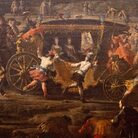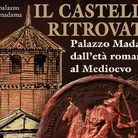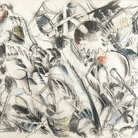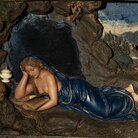Bai Ming. At the Crossroads of Worlds

Dal 24 April 2024 al 30 June 2024
Roma
Luogo: Galleria d’Arte Moderna e Contemporanea
Indirizzo: Viale delle Belle Arti 131
Orari: Dal martedì a domenica dalle 9 alle 19 Ultimo ingresso 45 minuti prima della chiusura
Costo del biglietto: intero: € 10, ridotto: € 2. Gratuito 25 aprile, 2 giugno e 4 novembre – visitatori di età inferiore a 18 anni – portatori di handicap e un accompagnatore che dimostri l'appartenenza a servizi di assistenza socio-sanitaria – giornalisti con tesserino in corso di validità – guide turistiche – soci ICOM – dipendenti MiC – docenti e studenti iscritti a determinate facoltà
Sito ufficiale: http://lagallerianazionale.com
La mostra Bai Ming. At the Crossroads of Worlds, organizzata dalla Galleria Nazionale d'Arte Moderna e Contemporanea in collaborazione con MondoMostre, con il contributo di Kwai Fung Foundation Limited, a cura di Jean-Louis Andral, direttore del Musée Picasso di Antibes, testimonia il profondo legame tra creatività antica e contemporanea, alla base dell’operato dell’artista e mette in luce la straordinaria capacità di Bai Ming di attraversare e fondere le opposte influenze.
Formatosi nell'arte della porcellana, una delle invenzioni dell’antica Cina, Bai Ming è considerato oggi tra i maggiori artisti al mondo nell’impiego di questo materiale. Insegna all'Università Tsinghua di Pechino, oltre a dirigere il dipartimento di Ceramica dell'Accademia di Arti e Design. Le sue opere, che comprendono anche dipinti ad inchiostro e lacche, oltre a installazioni, si trovano in numerose collezioni private e pubbliche in Cina e in Europa (come il British Museum di Londra e il Musée Cernuschi di Parigi) e lavora a Jingdezhen, capitale mondiale della porcellana.
Bai Ming è autore di un’arte che vive nello spazio tra tradizione e modernità. Armonizzando tra loro maestria e libertà di espressione, il percorso artistico di Bai Ming mostra chiaramente la sua volontà di mettere in discussione le nozioni di memoria e modernità, affermando il ruolo dell’arte come fondamentale elemento di impulso alla vita.
Nei suoi laboratori Bai Ming realizza da oltre trent'anni ceramiche che riproducono le forme classiche della tradizione cinese, vasi rouleau. Cambiando scala - l’artista dimostra la volontà di allontanarsi dalla loro funzione utilitaria per conferirgli un valore puramente decorativo, estetico o addirittura monumentale. Forme prive di funzione più vicine alle sculture, con una raffinata attenzione ai pieni e ai vuoti, per valorizzare il linguaggio dei materiali impiegati.
Bai Ming predilige l’uso della porcellana decorata in bianco e blu, introdotta in Cina intorno al 1330 da artigiani di origine persiana. "Quando si contempla una porcellana blu e bianca di alta qualità, si può perdere l'anima nel pensiero". L’artista reinventa questa decorazione con smalti e ossidi in riccioli e spire, indipendenti dalle forme su cui sono posti, svincolati dagli assi di simmetria o da qualsiasi presunta direzione di lettura. La sua è una decorazione pittorica che evoca paesaggi dove vagare e scoprire elementi tradizionali dell'arte paesaggistica cinese: rocce, montagne, piante, fiumi e nuvole. I titoli delle opere parlano da soli: Foglie rosse in autunno, La Terra, Pittura rupestre di paesaggio, Linee d'acqua, Mare rosso, solo per citarne alcuni, esaltando la molteplicità delle creazioni della natura. “Le nuvole sono senza forma, ma possono cambiare la nostra visione delle cose. […] Confondono la vista, ingannano i sensi, inducono l'immaginazione, spostano il tempo e lo spazio, incarnano la vitalità e cambiano il 'mondo’” (Bai Ming).
Questa reinvenzione di forme d’arte tradizionali si riflette inoltre nelle installazioni, che interagiscono con la luce e lo spazio, e nei dipinti dell'artista, che rivisita e riafferma la tradizione cinese utilizzando l'inchiostro e, più recentemente, la lacca. In questi ultimi, l’opacità quasi evanescente dell’inchiostro contrasta con la brillantezza della lacca, allo stesso tempo dialogando con le decorazioni semi-astratte delle porcellane, caratterizzate da linee ondulate e composizioni materiche. Bai Ming crea infatti dipinti che attingono alla sua pratica dell'arte ceramica e allo stesso tempo la nutrono. I suoi primi riferimenti pittorici furono Tapiès e Fontana, per il loro modo di rifiutare la bidimensionalità della tela, che Bai Ming fora o sulla quale attacca materiali come sabbia e foglie di tè. Questi riferimenti alla cultura cinese dimostrano ancora una volta la volontà dell’artista di riannodare il legame tra tradizione cinese e arte contemporanea la cui struttura di pensiero è occidentale.
L’esposizione alla Galleria Nazionale d'Arte Moderna e Contemporanea intende svelare le tante sfaccettature della sua produzione, attraverso un’attenta selezione di oltre ottanta opere che ripercorrono più di trent'anni di attività, dal 1993 ad oggi.
Si tratta di opere senza tempo, radicate in un’antichissima vicenda artistica, reinterpretate da Bai Ming con la sensibilità di un uomo del proprio tempo, accompagnata dalla tecnica e dall’ingegno di un autore multidisciplinare il cui linguaggio è essenzialmente contemporaneo, ma indipendente dai codici riproducibili che caratterizzano l’arte contemporanea del mondo globalizzato. Nei suoi viaggi, in occasione di residenze, mostre e visite, Bai Ming ha avuto la possibilità di conoscere e confrontarsi molto da vicino con la cultura occidentale, senza tuttavia perdere il senso di appartenenza e quel particolare legame con le sue origini e con l’identità spirituale della traduzione cinese. Il “crocevia di mondi”, al quale si riferisce il titolo della mostra romana: la sua opera ci spinge a liberarci della visione occidentale dell'arte cinese moderna invitandoci a includerla nel nostro universo spirituale, non più sul piano del mimetismo ma attraverso la scoperta della sua unicità.
SCARICA IL COMUNICATO IN PDF

-
 Dal 20 December 2025 al 20 April 2026
Caserta | Reggia di Caserta
Dal 20 December 2025 al 20 April 2026
Caserta | Reggia di Caserta
Regine: trame di cultura e diplomazia tra Napoli e l’Europa
-
 Dal 19 December 2025 al 23 March 2026
Torino | Palazzo Madama - Museo Civico d’Arte Antica
Dal 19 December 2025 al 23 March 2026
Torino | Palazzo Madama - Museo Civico d’Arte Antica
Il castello ritrovato. Palazzo Madama dall’età romana al medioevo
-
 Dal 17 December 2025 al 19 January 2026
Roma | Palazzo della Cancelleria
Dal 17 December 2025 al 19 January 2026
Roma | Palazzo della Cancelleria
De Humana Mensura di Linda Karshan
-
 Dal 18 December 2025 al 12 April 2026
Firenze | Gallerie degli Uffizi
Dal 18 December 2025 al 12 April 2026
Firenze | Gallerie degli Uffizi
Cera una volta. Sculture dalle collezioni medicee
-
 Dal 11 December 2025 al 9 April 2026
Firenze | Museo Archeologico Nazionale di Firenze
Dal 11 December 2025 al 9 April 2026
Firenze | Museo Archeologico Nazionale di Firenze
Icone di Potere e Bellezza
-
 Dal 11 December 2025 al 11 January 2026
Roma | Palazzo Esposizioni Roma
Dal 11 December 2025 al 11 January 2026
Roma | Palazzo Esposizioni Roma
Giorgio Morandi nella Collezione Eni. Un viaggio attraverso la storia culturale del cane a sei zampe e l’eredità di Enrico Mattei


